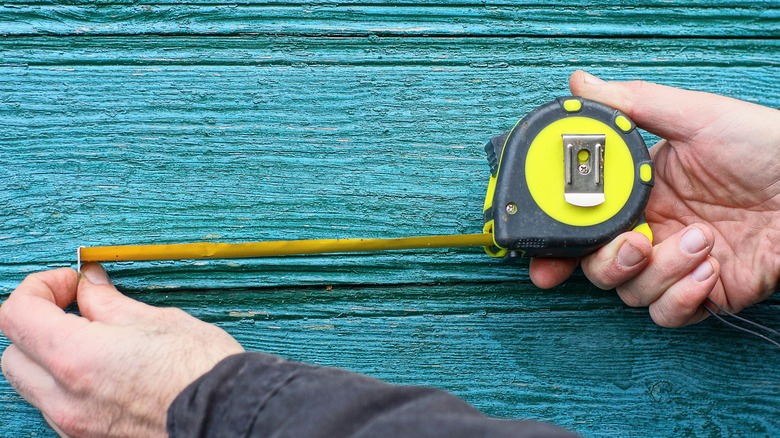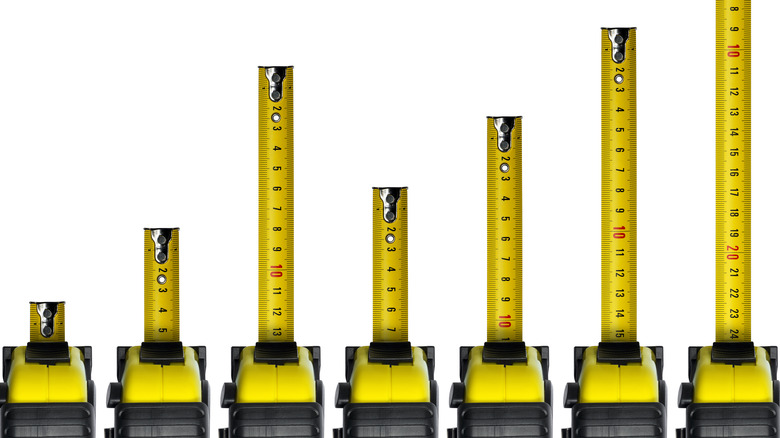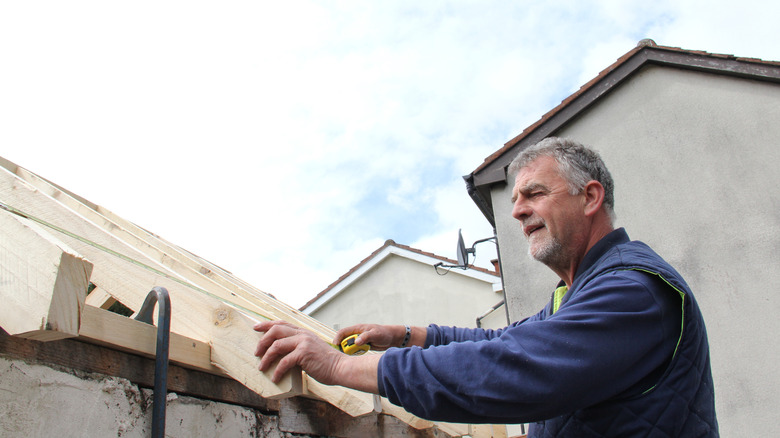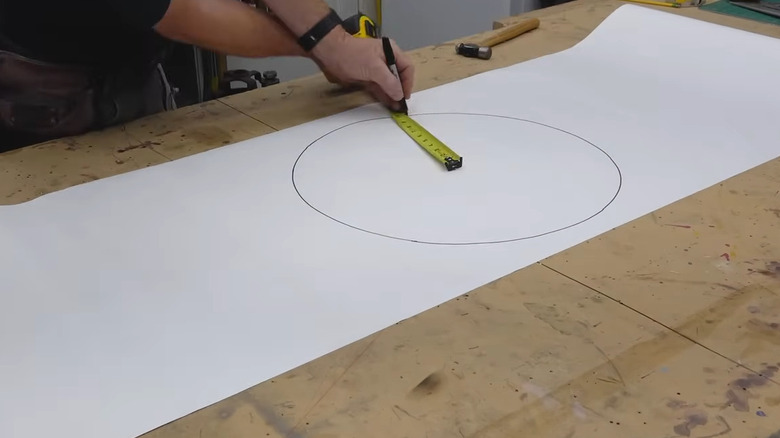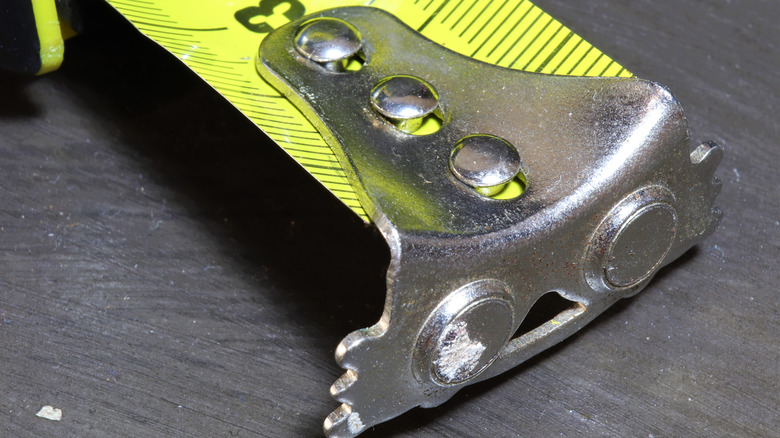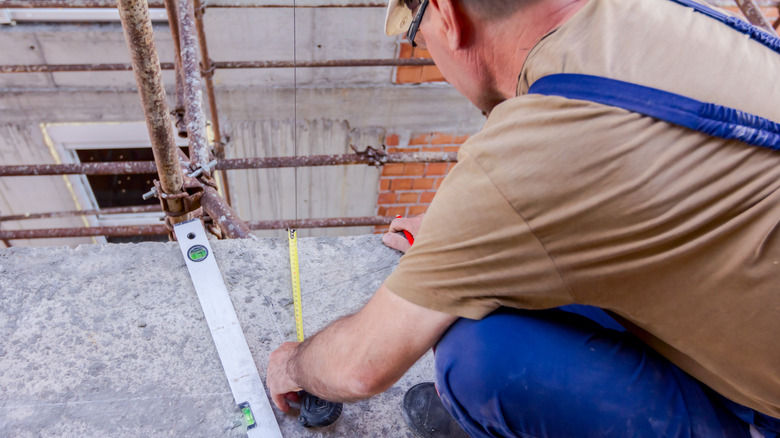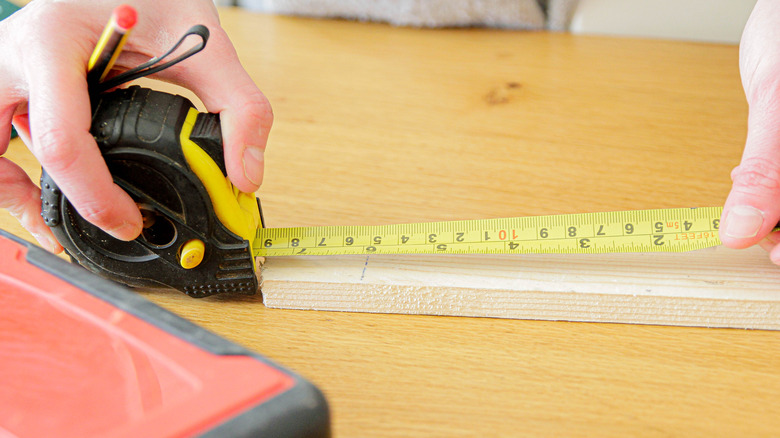7 Tips To Use A Tape Measure Like A Pro
Whether or not you're a tool enthusiast or frequent DIYer, a tape measure is a must-have. For a homeowner figuring out where to fit new furniture, a hobbyist starting work on a project, or a contractor planning out a large-scale job, few basic tools can match the convenience and versatility of these handy gadgets. The simple and straightforward functionality of a measuring tape is a big draw for most people. However, those who want to take things to the next level will find there's more to these tools than meets the eye. While tape measures may seem less advanced than many other tools, their array of hidden features and capabilities make them useful in a variety of situations.
The good news is that you don't need to be an expert-level handyman to become a pro at using a tape measure. SlashGear is here to point out these functions and provide instructions on how to use them correctly. First, take a look at our guide on how to read a tape measure and some common mistakes people make. The following advanced tips and tricks will take you from a newcomer to tape measure master in no time, and once you learn these finer points of tape measure use it'll be hard to look at yours the same way ever again.
How to pick the right tape measure
Tape measures come in many forms, from pocket-sized sewing tape to industrial-length open reel tape measures. There are even high-tech digital and laser models. For most professionals and newcomers, however, all you'll usually need is a traditional cased steel tape measure. Along with being compact and easy to transport, they're typically made of durable plastic or metal to protect the tape and spring mechanism.
It's important to find a tape measure of an appropriate length for your needs. If you 're going to use it for general household tasks or DIY projects, a standard 16- or 25-foot option will more than likely suit your needs. However, if you know that you'll need something that can go further, you can find tape measures that reach or exceed 100 feet in length. If the tape measure doesn't state its length on the case, you can sometimes find it on the end of the blade.
You'll also have to make sure that the tape measure you select has markings and measurements that are relevant to your project. While many tape measures sold in the United States only have Standard American English (SAE) — or inch — measurements, many also feature a combination of both SAE and metric markings to accommodate a wider variety of users. Whichever road you go down, be sure that the markings are well-defined and easy to read. There are a variety of other handy features you'll find present in some tape measures such as belt clips, wrist straps, and magnetic mounts.
How to take accurate corner measurements
You'll find that there are some tasks that even your tape measure has difficulty achieving, such as getting accurate measurements when you come to a corner. Your first instinct may be to bend the blade to make it fit into the space, but the tape won't lie flat along its entire run, creating gaps that will throw off your measurements. Additionally, repeatedly using a metal tape measure in this way will put strain on the blade that can cut down on the life of your tool. There's a simpler method you can employ to get accurate measurements around corners. Just take two measurements, one for each side that meets at the corner.
Add the two distances together to get the precise measurement around the corner. A similar technique can also be used for measuring items that are longer than your tape measure. Simply mark the tape's end, measure from there, and add the measurement to the length of your tape. Bending your tape measure is not the most accurate way to measure corners, but from time to time you might need a quick reading. Pull out just enough of the blade to make your measurement, pin it down close to the free end, and firmly flex the blade into the corner until it's pressed as flat as possible along its entire length.
The right pencil (and how you use it) can make a big difference
It doesn't take an expert to know how important a pencil is for marking out measurements while using a tape measure. However, the pencil you use and how you use it can affect the accuracy of your measurements. Here are some things to keep in mind when using a pencil along with a tape measure. Keeping your pencil nice and sharp for the duration of any given task is of utmost importance.
A dull pencil tip isn't only messy looking, but it can throw off your measurement by a couple of millimeters. While this may not seem that big of a concern at first, precision matters for some jobs like window installation, hanging trim, and installing new flooring. So whether you're using a regular No. 2 pencil or a specialty carpenter's pencil, you should always keep a sharpener or utility blade on hand. Depending on the kind of tape measure you have, you might be able to make markings directly on the blade with your pencil. This helps save time if you need to measure more than one item of the same length. Many tape measures have black diamonds stamped at regular intervals to help you properly space out joists.
Use this handy feature to make perfect circles
Tape measures aren't nearly as singular in functionality as some may assume. Once you unlock the reasoning behind some of these hidden features, you'll have a greater appreciation for what goes into a tape measure's engineering along with an idea of its full potential. For example, while tape measures are usually used to measure straight lines, you may be surprised to learn that you can also use a tape measure to draw circles or arcs. At the end of your tape measure hook, you'll find a small hole or slot.
This feature's purpose is to grab on to the head of a screw or nail, allowing you to extend the tape measure without the need for anyone to hold on to the other end. While useful in its own right, you can expand upon this feature by using it to draw curves and even circles. Place a nail in the center of the intended circle or arc and attach it to the hook. Extend your tape measure to your desired radius measurement, hold your pencil to the tape edge, and swivel the tape around with one hand while using the other to hold the pencil steady.
The tape measure tab wiggles for a reason
While we're on the subject of the hook at the end of your tape measure, it's worth noting another aspect of this feature that doesn't give away its function at first glance. But while you can probably ignore the nail hook at the end of a tape measure, the wiggly tab may have you thinking that something is wrong with your tape. However, this is a valuable feature once you learn how to use it right. Believe it or not, the tab at the end of your tape measure is designed to wiggle as a way of ensuring greater accuracy. The tab has a thickness of around 1/16 of an inch and how you position it will determine if you're adding or subtracting that bit from your overall measurement.
Pushing the tab into a perpendicular surface will add the 1/16 of an inch to your measurement, while hooking it onto an edge and pulling will subtract it. Many people get these backwards or press down on the tab as a way of keeping the tape measure steady, but this can lead to inaccurate measurements. To prevent this, make sure you're holding the blade itself and pressing it flush with the surface to keep the tape measure stable. If the tab is giving you trouble, you can remove it from the equation entirely by starting your measurement at the 1 inch marker and subtracting that inch from your measurement.
Tilt the blade to get the best measurements
Even if you never find yourself using a tape measure's more specialized features, it's likely that you'll end up using it as a straightedge at some point. This may seem odd, given the cupped design of the blade. While this allows the blade to be flexed in one orientation while keeping it rigid in the other, it can be a bit tricky to position the tape in a way that allows you to make a clean, straight line. Some people get around this by flipping the tape around or making their marks under the curve. However, the tape will flex if turned over and drawing under the curve can lead to squiggly lines or inaccurate markings.
Instead, you should tilt the blade forward, allowing the edge to touch the surface, and make your straight line along that edge. The easiest way to do this is by grabbing the tape between the thumb and forefinger of your non-dominant hand. Trace along the edge of the tape measure with your writing hand, keeping steady pressure on the tape with the other hand. You'll also want to be conscious of how much tape to pull out and where to put your hands. Extend the blade by a few more inches than you need and lock the tape in place before tilting it against your work surface.
Take good care of your tape measure
Given that your tape measure doesn't have to go through the abuse a hammer, saw, or power drill does, it's easy to assume that yours will last forever. However, as with any tool, tape measures age over time and with repeated use. While there's no fighting this fact, you can ensure that you get the most out of your tape measure by being mindful of how you use, store, and maintain it. When your tape measure is in use, be conscious of how you're extending and retracting the blade.
Aggressively yanking out the blade or letting it snap back quickly may help save fractions of a second each time, but doing so regularly can lead to issues with the spring mechanism. Instead, maintain a gentle touch when extracting or replacing the blade or using the tape lock. You'll want to bring that same level of care to how you store the tape measure. Water and heat can cause the blade to rust or warp, so keep it somewhere cool and dry. Clean it with lint-free cloths and a mild soap, and spray a little WD-40 on the blade and let it dry before retracting. If your tape measure has gouges, creases, or similar damage, it might be time to get a new one.
